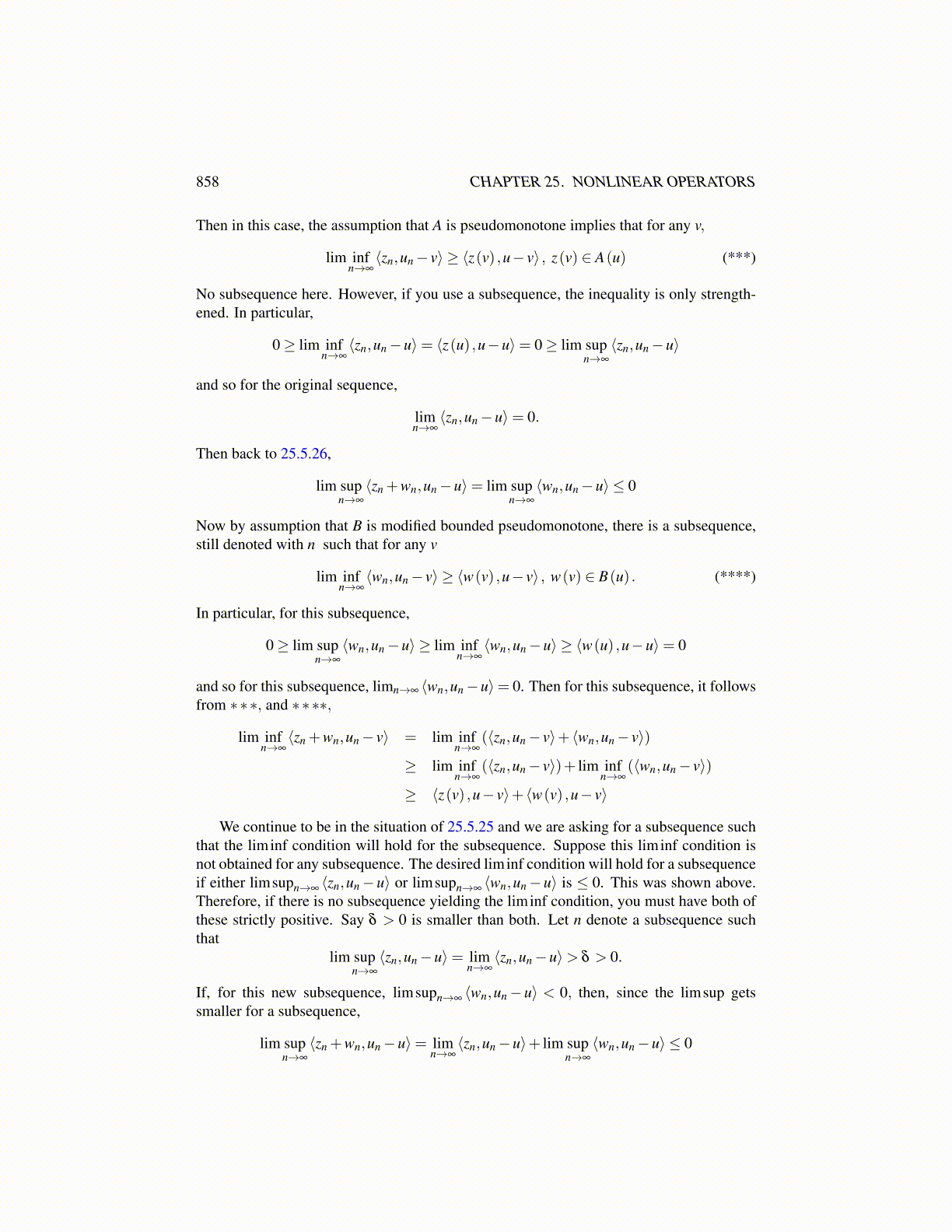
858 CHAPTER 25. NONLINEAR OPERATORS
Then in this case, the assumption that A is pseudomonotone implies that for any v,
lim infn→∞⟨zn,un− v⟩ ≥ ⟨z(v) ,u− v⟩ , z(v) ∈ A(u) (***)
No subsequence here. However, if you use a subsequence, the inequality is only strength-ened. In particular,
0≥ lim infn→∞⟨zn,un−u⟩= ⟨z(u) ,u−u⟩= 0≥ lim sup
n→∞
⟨zn,un−u⟩
and so for the original sequence,
limn→∞⟨zn,un−u⟩= 0.
Then back to 25.5.26,
lim supn→∞
⟨zn +wn,un−u⟩= lim supn→∞
⟨wn,un−u⟩ ≤ 0
Now by assumption that B is modified bounded pseudomonotone, there is a subsequence,still denoted with n such that for any v
lim infn→∞⟨wn,un− v⟩ ≥ ⟨w(v) ,u− v⟩ , w(v) ∈ B(u) . (****)
In particular, for this subsequence,
0≥ lim supn→∞
⟨wn,un−u⟩ ≥ lim infn→∞⟨wn,un−u⟩ ≥ ⟨w(u) ,u−u⟩= 0
and so for this subsequence, limn→∞ ⟨wn,un−u⟩= 0. Then for this subsequence, it followsfrom ∗∗∗, and ∗∗∗∗,
lim infn→∞⟨zn +wn,un− v⟩ = lim inf
n→∞(⟨zn,un− v⟩+ ⟨wn,un− v⟩)
≥ lim infn→∞
(⟨zn,un− v⟩)+ lim infn→∞
(⟨wn,un− v⟩)
≥ ⟨z(v) ,u− v⟩+ ⟨w(v) ,u− v⟩
We continue to be in the situation of 25.5.25 and we are asking for a subsequence suchthat the liminf condition will hold for the subsequence. Suppose this liminf condition isnot obtained for any subsequence. The desired liminf condition will hold for a subsequenceif either limsupn→∞ ⟨zn,un−u⟩ or limsupn→∞ ⟨wn,un−u⟩ is ≤ 0. This was shown above.Therefore, if there is no subsequence yielding the liminf condition, you must have both ofthese strictly positive. Say δ > 0 is smaller than both. Let n denote a subsequence suchthat
lim supn→∞
⟨zn,un−u⟩= limn→∞⟨zn,un−u⟩> δ > 0.
If, for this new subsequence, limsupn→∞ ⟨wn,un−u⟩ < 0, then, since the limsup getssmaller for a subsequence,
lim supn→∞
⟨zn +wn,un−u⟩= limn→∞⟨zn,un−u⟩+ lim sup
n→∞
⟨wn,un−u⟩ ≤ 0